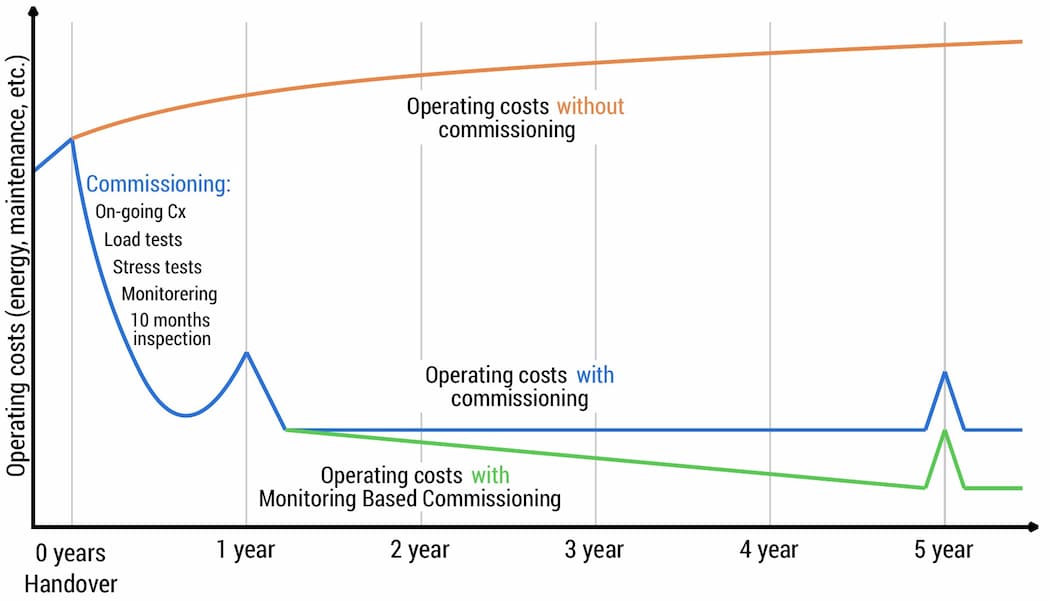- What is sustainability in construction projects?
- Sustainability certification for buildings
- DGNB and the commissioning process
- DGNB Platinum, Gold, and Silver
- Cx and DGNB
What is sustainability in construction projects?
The term "sustainability" often encompasses three related topics:
- Environmental sustainability
- Social sustainability
- Economic sustainability
In the construction industry, people often choose to focus on sustainability in order for the finished building to achieve a sustainability certification.
When a building is certified sustainable, its value typically increases, and it can begin to attract investments using its classification in the EU Taxonomy.
Sustainability certification for buildings
Construction projects typically aim for one of three primary sustainability certifications:
- DGNB, Green Building Council
- BREEAM, Building Research Establishment
- LEED, Leadership in Energy and Environmental Design
All three focus on making buildings more sustainable, but their approaches are distinct. Each certification programme also has different emphases, since they were developed in different countries.
That said, all three programmes reward developers for using commissioning to varying degrees.
In the United States, commissioning was implemented during the energy crisis of the 1970s, as it was discovered that commissioning resulted in improved energy efficiency and operational processes. This is shown in the illustration below:

DGNB and the commissioning process
DGNB imposes explicit Cx process requirements in section PRO2.3. The DGNB guide's goal is to promote efficient handover of the finished building and to ensure that its installations function correctly and in an energy-efficient manner.
The DGNB requirements are linked to the UN's Global Goals for sustainable development. The commissioning process falls under Goal 7, "Affordable and clean energy", and Goal 12.2, "Sustainable management and use of natural resources".
The 2020 edition of the DGNB manual imposes DS3090 and ASHRAE Std202 requirements in a slightly stricter approach to Cx.
The commissioning requirements are divided into two groups: "Measurement and recording, revision, and performance testing" (up to 50 points) and "Commissioning" (up to 60 points).
Measurement and recording, revision, and performance testing
These requirements are related to conducting functional and performance testing.
- A plan must be developed for measuring and monitoring technical installations, ensuring that the number of measurement points is sufficient to test each installation's functionality. All system elements are subjected to functional testing per the requirements in the Danish Building Regulations. (30 points)
- Additionally, cross-disciplinary and system-orientated performance tests beyond the scope of the functional testing requirements in the Danish Building Regulations are performed. (50 points)
Commissioning
The requirements for the commissioning process itself are in line with the Danish standard DS 3090.
- Documentation of the establishment of a commissioning organisation in charge of commissioning activities up to and including the 1-year review (+10 points)
- Documentation of the fact that the commissioning organisation's manager and professionals are employed by a company not involved in the design and execution of the construction (i.e. if, for example, construction management is tendered separately, the commissioning manager may work for the construction management company provided that the same company is not involved in design and execution) (+10 points)
- Documentation of measurable commissioning requirements and periods reserved in the primary construction schedule for all DS 3090 activities, including their dependencies on the completion of planned design and execution activities (+10 points)
- Documentation of the existence of a project basis and the performance of cross-disciplinary commissioning reviews of the project proposal and primary plan (+10 points)
- The commissioning process is conducted with ongoing revisions and adjustments for the first 14 months of operation, or it is agreed upon that this procedure must be completed. Complete documentation has been prepared, or it is agreed upon that such documentation is to be prepared. Functional and performance inspections are also conducted to ensure that the client's particular requirements have been met. A concept has been implemented to ensure that use is continuously monitored and optimised (+10 points)
- Documentation that, in addition to the execution of a complete commissioning process, a plan exists for the performance of ongoing commissioning activities, including monitoring-based commissioning, as well as an organisational diagram for the organisation which is to take over for the organisation in charge of the initial operating period after one year of operation (+10 points)
The DGNB's commissioning documentation requirements
The above requirements are presented in the commissioning section of the DGNB manual, and all of them must be documented. The documentation requirements request reports from tests performed and documents specified in DS 3090.
If you use CxPlanner, you will automatically receive documentation for each requirement, allowing you to score the maximum number of points.
DGNB Platinum, Gold, and Silver
The DGNB certification programme is divided into three major categories: Platinum, Gold, and Silver. The more points you earn, the higher the certification rank you receive.
- DGNB Platinum
- DGNB Gold
- DGNB Silver
Cx and DGNB
Construction projects must work with a DGNB consultant/advisor who can indicate where points may be scored. When commissioning is part of the process (and it always should be), that process must be planned, too.
If you use CxPlanner's template for the Cx process, you will already have unrestricted access to the test formats and documents that must be presented.
We have helped to build Cx processes for many DGNB projects, so it doesn't take much extra work to get a practical, easily integrated process.